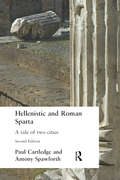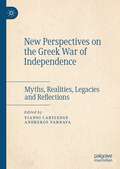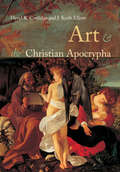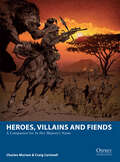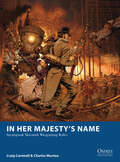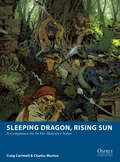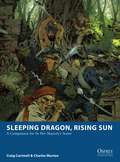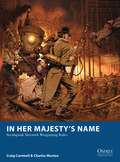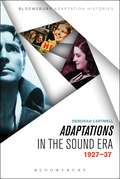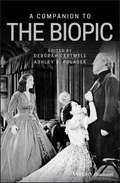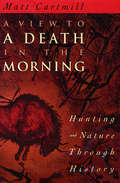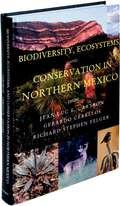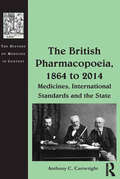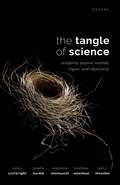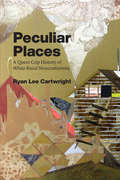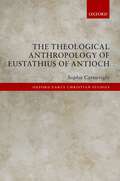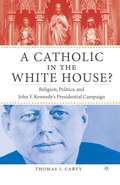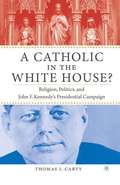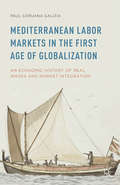- Table View
- List View
Hellenistic and Roman Sparta
by Paul Cartledge Antony SpawforthIn this new edition, Paul Cartledge and Antony Spawforth have taken account of recent finds and scholarship to revise and update their authoritative overview of later Spartan history, and of the social, political, economic and cultural changes in the Spartan community.This original and compelling account is especially significant in challenging the conventional misperception of Spartan 'decline' after the loss of her status as a great power on the battlefield in 371 BC. The book's focus on a frequently overlooked period makes it important not only for those interested specifically in Sparta, but also for all those concerned with Hellenistic Greece, and with the life of Greece and other Greek-speaking provinces under non-Roman rule.
Hellenistic and Roman Sparta
by Paul Cartledge Antony SpawforthIn this new edition, Paul Cartledge and Antony Spawforth have taken account of recent finds and scholarship to revise and update their authoritative overview of later Spartan history, and of the social, political, economic and cultural changes in the Spartan community.This original and compelling account is especially significant in challenging the conventional misperception of Spartan 'decline' after the loss of her status as a great power on the battlefield in 371 BC. The book's focus on a frequently overlooked period makes it important not only for those interested specifically in Sparta, but also for all those concerned with Hellenistic Greece, and with the life of Greece and other Greek-speaking provinces under non-Roman rule.
New Perspectives on the Greek War of Independence: Myths, Realities, Legacies and Reflections
by Yianni Cartledge Andrekos VarnavaThis book marks the 200-year anniversary of uprisings in the Ottoman Balkans between February and March 1821, which became known in the West as the beginnings of the Greek War of Independence (1821–1832), and led to the formation of the modern Greek state. It explores the war and its impact on societies involved by delving into the myths that surround it, the realities that have often been ignored or suppressed, and its lasting legacies on national identities and histories. It also explores memory and commemoration in Greece, in other countries impacted, and the Greek diaspora. This book offers a fresh perspective on this pivotal event in Greek, Ottoman, Balkan, Mediterranean, European, and world histories. It presents new research and reflections to connect the war to wider history and to understand its importance across the last 200 years.
Art and the Christian Apocrypha
by David R. Cartlidge J. Keith ElliotThe Christian canon of scripture, known as the New Testament, excluded many of the Church's traditional stories about its origins. Although not in the Bible, these popular stories have had a powerful influence on the Church's traditions and theology, and a particularly marked effect on visual representations of Christian belief. This book provides a lucid introduction to the relationship between the apocryphal texts and the paintings, mosaics, and sculpture in which they are frequently paralleled, and which have been so significant in transmitting these non-Biblical stories to generations of churchgoers.
Art and the Christian Apocrypha
by David R. Cartlidge J. Keith ElliotThe Christian canon of scripture, known as the New Testament, excluded many of the Church's traditional stories about its origins. Although not in the Bible, these popular stories have had a powerful influence on the Church's traditions and theology, and a particularly marked effect on visual representations of Christian belief. This book provides a lucid introduction to the relationship between the apocryphal texts and the paintings, mosaics, and sculpture in which they are frequently paralleled, and which have been so significant in transmitting these non-Biblical stories to generations of churchgoers.
Heroes, Villains and Fiends: A Companion for In Her Majesty’s Name (Osprey Wargames #3)
by Craig Cartmell Charles MurtonIt is 1895 and the future depends not upon the actions of governments but upon those of the Adventuring Companies, and will be shaped by countless engagements in city streets, ancient ruins, dense jungles, high mountains and boundless deserts. In America, good men fight to preserve their hard-won liberty and the great drive west is stalled by Native American mystics and powerful outlaw gangs. In Africa, native forces fight to push back the Pax Britannica – no longer is a Lee-Metford rifle and a disciplined resolve enough to put the foe to flight. In Europe, darkness gathers around the Austro-Hungarian court and the Great Powers watch warily, knowing its fall could precipitate a war to end all wars. Heroes, Villains and Fiends presents new Companies, from the rebellious Zulu and Apache to the spies of the Okhrana and Secret Service, and the mysterious forces of such groups as the Knights Templar and the sinister Hellfire Club. With equipment, Talents and Mystical Powers, additional scenarios and a sample campaign, Heroes, Villains and Fiends opens up new possibilities for In Her Majesty's Name.
In Her Majesty’s Name: Steampunk Skirmish Wargaming Rules (Osprey Wargames #3)
by Craig Cartmell Charles MurtonIt is 1895 and the world is in turmoil. The Great Powers compete for resources and the latest technology, and an undeclared and secret war rages between them all. This is battleground of the Adventuring Companies. These clandestine agents of the Great Powers operate in the shadows, matching skills and wits in pursuit of the newest scientific formulae or powerful occult artifacts. In Her Majesty's Name sets these adventuring companies against each other in one-off encounters and in longer narrative campaigns. Companies are usually comprised of just 4–15 figures and two players could easily play three games in an evening, making an on-going campaign a highly viable option. In Her Majesty's Name has been designed to allow maximum versatility for the player – if you can imagine it, the system will help you build it. There is, however, a wealth of material provided in the book, covering weird science, mystical powers, and a range of pre-generated adventuring companies, including the British Explorers' Club, the Prussian Society of Thule, the US Marine Corps, the Légion Étrangère, the revolutionaries of the Brick Lane Commune, ancient Egyptian cults, and the mysterious Black Dragon Tong.
Sleeping Dragon, Rising Sun: A Companion for In Her Majesty’s Name (Osprey Wargames #3)
by Craig Cartmell Charles MurtonChina, the greatest empire the world had ever known, is weak and divided after a series of humiliating defeats in the Opium Wars, and the divine Empress' court harbours many who deeply resent the westerners who inflicted and now take advantage of these losses. Japan, on the other hand, has embraced the West with open arms. After centuries of isolation the Japanese now march forwards and accept technologies that, a few decades before, would have been regarded as witchcraft. Possessed of the East's most modern army, Japan now looks avariciously towards its neighbours. The next decade will decide whether the ancient empires of the East survive or are washed away, and every one of the Great Powers wants their slice.
Sleeping Dragon, Rising Sun: A Companion for In Her Majesty’s Name (Osprey Wargames #3)
by Craig Cartmell Charles Murton Fabien Esnard-LascombeChina, the greatest empire the world had ever known, is weak and divided after a series of humiliating defeats in the Opium Wars, and the divine Empress' court harbours many who deeply resent the westerners who inflicted and now take advantage of these losses. Japan, on the other hand, has embraced the West with open arms. After centuries of isolation the Japanese now march forwards and accept technologies that, a few decades before, would have been regarded as witchcraft. Possessed of the East's most modern army, Japan now looks avariciously towards its neighbours. The next decade will decide whether the ancient empires of the East survive or are washed away, and every one of the Great Powers wants their slice.
In Her Majesty’s Name: Steampunk Skirmish Wargaming Rules (Osprey Wargames)
by Craig Cartmell Charles Murton Fabien Esnard-Lascombe Jesse McGibneyIt is 1895 and the world is in turmoil. The Great Powers compete for resources and the latest technology, and an undeclared and secret war rages between them all. This is battleground of the Adventuring Companies. These clandestine agents of the Great Powers operate in the shadows, matching skills and wits in pursuit of the newest scientific formulae or powerful occult artifacts. In Her Majesty's Name sets these adventuring companies against each other in one-off encounters and in longer narrative campaigns. Companies are usually comprised of just 4–15 figures and two players could easily play three games in an evening, making an on-going campaign a highly viable option. In Her Majesty's Name has been designed to allow maximum versatility for the player – if you can imagine it, the system will help you build it. There is, however, a wealth of material provided in the book, covering weird science, mystical powers, and a range of pre-generated adventuring companies, including the British Explorers' Club, the Prussian Society of Thule, the US Marine Corps, the Légion Étrangère, the revolutionaries of the Brick Lane Commune, ancient Egyptian cults, and the mysterious Black Dragon Tong.
Adaptations in the Sound Era: 1927-37 (Bloomsbury Adaptation Histories)
by Deborah CartmellThere is no disputing that the coming of sound heralded a new era for adaptations. We take it for granted today that a film is enhanced by sound but it was not a view unanimously held in the early period of sound cinema. While there was a substantial degree of skepticism in the late 1920s and early 30s about the advantages of sound, what we would call technophobia today, the inclusion of speech in screen versions of literary and theatrical works, undeniably revised what it was to be an adaptation: words. Focusing on promotional materials, Adaptations in the Sound Era tracks early attempts to promote sound through the elevation of words in adaptations in the early sound period. The popular appeal of these films clearly stands in opposition to academic regard for them and the book reflects on the presence and marketing of 'words' in a variety of adaptations, from the introduction of sound in the late 1920s to the mid 1930s. This book contextualizes a range of adaptations in relation to debates about 'picturizations' of books in the early sound era, including reactions to the talking adaptation by writers such as, Irwin Panofsky, Aldous Huxley and Graham Greene. Film adaptations of Shakespeare, Dickens, gothic fiction and biopics are also discussed in relation to their use and promotion of sound or, more precisely, words.
Adaptations in the Sound Era: 1927-37 (Bloomsbury Adaptation Histories)
by Deborah CartmellThere is no disputing that the coming of sound heralded a new era for adaptations. We take it for granted today that a film is enhanced by sound but it was not a view unanimously held in the early period of sound cinema. While there was a substantial degree of skepticism in the late 1920s and early 30s about the advantages of sound, what we would call technophobia today, the inclusion of speech in screen versions of literary and theatrical works, undeniably revised what it was to be an adaptation: words. Focusing on promotional materials, Adaptations in the Sound Era tracks early attempts to promote sound through the elevation of words in adaptations in the early sound period. The popular appeal of these films clearly stands in opposition to academic regard for them and the book reflects on the presence and marketing of 'words' in a variety of adaptations, from the introduction of sound in the late 1920s to the mid 1930s. This book contextualizes a range of adaptations in relation to debates about 'picturizations' of books in the early sound era, including reactions to the talking adaptation by writers such as, Irwin Panofsky, Aldous Huxley and Graham Greene. Film adaptations of Shakespeare, Dickens, gothic fiction and biopics are also discussed in relation to their use and promotion of sound or, more precisely, words.
A Companion to the Biopic
by Deborah Cartmell Ashley D. PolasekThe most comprehensive reference text of theoretical and historical discourse on the biopic film The biopic, often viewed as the most reviled of all film genres, traces its origins to the early silent era over a century ago. Receiving little critical attention, biopics are regularly dismissed as superficial, formulaic, and disrespectful of history. Film critics, literary scholars and historians tend to believe that biopics should be artistic, yet accurate, true-to-life representations of their subjects. Moviegoing audiences, however, do not seem to hold similar views; biopics continue to be popular, commercially viable films. Even the genre’s most ardent detractors will admit that these films are often very watchable, particularly due to the performance of the lead actor. It is increasingly common for stars of biographical films to garner critical praise and awards, driving a growing interest in scholarship in the genre. A Companion to the Biopic is the first global and authoritative reference on the subject. Offering theoretical, historical, thematic, and performance-based approaches, this unique volume brings together the work of top scholars to discuss the coverage of the lives of authors, politicians, royalty, criminals, and pop stars through the biopic film. Chapters explore evolving attitudes and divergent perspectives on the genre with topics such as the connections between biopics and literary melodramas, the influence financial concerns have on aesthetic, social, or moral principles, the merger of historical narratives with Hollywood biographies, stereotypes and criticisms of the biopic genre, and more. This volume: Provides a systematic, in-depth analysis of the biopic and considers how the choice of historical subject reflects contemporary issues Places emphasis on films that portray race and gender issues Explores the uneven boundaries of the genre by addressing what is and is not a biopic as well as the ways in which films simultaneously embrace and defy historical authenticity Examines the distinction between reality and ‘the real’ in biographical films Offers a chronological survey of biopics from the beginning of the 20th century A Companion to the Biopic is a valuable resource for researchers, scholars, and students of history, film studies, and English literature, as well as those in disciplines that examine interpretations of historical figures
A View to a Death in the Morning: Hunting and Nature Through History
by Matt CartmillWhat brought the ape out of the trees, and so the man out of the ape, was a taste for blood. This is how the story went, when a few fossils found in Africa in the 1920s seemed to point to hunting as the first human activity among our simian forebears—the force behind our upright posture, skill with tools, domestic arrangements, and warlike ways. Why, on such slim evidence, did the theory take hold? In this engrossing book Matt Cartmill searches out the origins, and the strange allure, of the myth of Man the Hunter. An exhilarating foray into cultural history, A View to a Death in the Morning shows us how hunting has figured in the western imagination from the myth of Artemis to the tale of Bambi—and how its evolving image has reflected our own view of ourselves. A leading biological anthropologist, Cartmill brings remarkable wit and wisdom to his story. Beginning with the killer-ape theory in its post–World War II version, he takes us back through literature and history to other versions of the hunting hypothesis. Earlier accounts of Man the Hunter, drafted in the Renaissance, reveal a growing uneasiness with humanity’s supposed dominion over nature. By delving further into the history of hunting, from its promotion as a maker of men and builder of character to its image as an aristocratic pastime, charged with ritual and eroticism, Cartmill shows us how the hunter has always stood between the human domain and the wild, his status changing with cultural conceptions of that boundary. Cartmill’s inquiry leads us through classical antiquity and Christian tradition, medieval history, Renaissance thought, and the Romantic movement to the most recent controversies over wilderness management and animal rights. Modern ideas about human dominion find their expression in everything from scientific theories and philosophical assertions to Disney movies and sporting magazines. Cartmill’s survey of these sources offers fascinating insight into the significance of hunting as a mythic metaphor in recent times, particularly after the savagery of the world wars reawakened grievous doubts about man’s place in nature. A masterpiece of humanistic science, A View to a Death in the Morning is also a thoughtful meditation on what it means to be human, to stand uncertainly between the wilderness of beast and prey and the peaceable kingdom. This richly illustrated book will captivate readers on every side of the dilemma, from the most avid hunters to their most vehement opponents to those who simply wonder about the import of hunting in human nature.
Biodiversity, Ecosystems, and Conservation in Northern Mexico
by Jean-Luc E. Cartron Gerardo Ceballos Richard Stephen FelgerThis book describes the biodiversity and biogeography of nothern Mexico, documents the biological importance of regional ecosystems and the impacts of human land use on the conservation status of plants and wildlife. It should become the standard source document for the conservation status of species and ecosystems in this region, which is of unusual biological interest because of its high biodiversity and highly varied landscape and biological zonation.
The British Pharmacopoeia, 1864 to 2014: Medicines, International Standards and the State (The History of Medicine in Context)
by Anthony C. CartwrightThe British Pharmacopoeia has provided official standards for the quality of substances, medicinal products and articles used in medicine since its first publication in 1864. It is used in over 100 countries and remains an essential global reference in pharmaceutical research and development and quality control. This book explores how these standards have been achieved through a comprehensive review of the history and development of the pharmacopoeias in the UK, from the early London, Edinburgh and Dublin national pharmacopoeias to the creation of the British Pharmacopoeia and its evolution over 150 years. Trade in medicinal substances and products has always been global, and the British Pharmacopoeia is placed in its global context as an instrument of the British Empire as it first sought to cover the needs of countries such as India and latterly as part of its role in international harmonisation of standards in Europe and elsewhere. The changing contents of the pharmacopoeias over this period reflect the changes in medical practice and the development of dosage forms from products dispensed by pharmacists to commercially manufactured products, from tinctures to the latest monoclonal antibody products. The book will be of equal value to historians of medicine and pharmacy as to practitioners of medicine, pharmacy and pharmaceutical analytical chemistry.
The British Pharmacopoeia, 1864 to 2014: Medicines, International Standards and the State (The History of Medicine in Context)
by Anthony C. CartwrightThe British Pharmacopoeia has provided official standards for the quality of substances, medicinal products and articles used in medicine since its first publication in 1864. It is used in over 100 countries and remains an essential global reference in pharmaceutical research and development and quality control. This book explores how these standards have been achieved through a comprehensive review of the history and development of the pharmacopoeias in the UK, from the early London, Edinburgh and Dublin national pharmacopoeias to the creation of the British Pharmacopoeia and its evolution over 150 years. Trade in medicinal substances and products has always been global, and the British Pharmacopoeia is placed in its global context as an instrument of the British Empire as it first sought to cover the needs of countries such as India and latterly as part of its role in international harmonisation of standards in Europe and elsewhere. The changing contents of the pharmacopoeias over this period reflect the changes in medical practice and the development of dosage forms from products dispensed by pharmacists to commercially manufactured products, from tinctures to the latest monoclonal antibody products. The book will be of equal value to historians of medicine and pharmacy as to practitioners of medicine, pharmacy and pharmaceutical analytical chemistry.
The Tangle of Science: Reliability Beyond Method, Rigour, and Objectivity
by Nancy Cartwright Eleonora Montuschi Jeremy Hardie Matthew Soleiman Ann C. ThresherScience is remarkably reliable. It puts people on the moon, performs laser eye surgery, tells us about ancient civilizations and species, and predicts the future of our climate. What underwrites this reliability? This book argues that the standard answers—the scientific method, rigour, and objectivity—are insufficient for the job. Here we propose a new model of science which places its products front and centre. In The Tangle of Science we show how any reliable piece of science is underpinned by a vast, diverse, and thick network of other scientific products. In doing so we bring back into focus areas of science that have been long neglected, emphasizing how every product, from the screws that hold the space shuttle together, to ways of measuring the consumer price index, to Einstein's theory of general relativity, work together to support results we can trust.
The Tangle of Science: Reliability Beyond Method, Rigour, and Objectivity
by Nancy Cartwright Eleonora Montuschi Jeremy Hardie Matthew Soleiman Ann C. ThresherScience is remarkably reliable. It puts people on the moon, performs laser eye surgery, tells us about ancient civilizations and species, and predicts the future of our climate. What underwrites this reliability? This book argues that the standard answers—the scientific method, rigour, and objectivity—are insufficient for the job. Here we propose a new model of science which places its products front and centre. In The Tangle of Science we show how any reliable piece of science is underpinned by a vast, diverse, and thick network of other scientific products. In doing so we bring back into focus areas of science that have been long neglected, emphasizing how every product, from the screws that hold the space shuttle together, to ways of measuring the consumer price index, to Einstein's theory of general relativity, work together to support results we can trust.
Peculiar Places: A Queer Crip History of White Rural Nonconformity
by Ryan Lee CartwrightThe queer recluse, the shambling farmer, the clannish hill folk—white rural populations have long disturbed the American imagination, alternately revered as moral, healthy, and hardworking, and feared as antisocial or socially uncouth. In Peculiar Places, Ryan Lee Cartwright examines the deep archive of these contrary formations, mapping racialized queer and disability histories of white social nonconformity across the rural twentieth-century United States. Sensationalized accounts of white rural communities’ aberrant sexualities, racial intermingling, gender transgressions, and anomalous bodies and minds, which proliferated from the turn of the century, created a national view of the perversity of white rural poverty for the American public. Cartwright contends that these accounts, extracted and estranged from their own ambivalent forum of community gossip, must be read in kind: through a racialized, materialist queercrip optic of the deeply familiar and mundane. Taking in popular science, documentary photography, news media, documentaries, and horror films, Peculiar Places orients itself at the intersections of disability studies, queer studies, and gender studies to illuminate a racialized landscape both profoundly ordinary and familiar.
Peculiar Places: A Queer Crip History of White Rural Nonconformity
by Ryan Lee CartwrightThe queer recluse, the shambling farmer, the clannish hill folk—white rural populations have long disturbed the American imagination, alternately revered as moral, healthy, and hardworking, and feared as antisocial or socially uncouth. In Peculiar Places, Ryan Lee Cartwright examines the deep archive of these contrary formations, mapping racialized queer and disability histories of white social nonconformity across the rural twentieth-century United States. Sensationalized accounts of white rural communities’ aberrant sexualities, racial intermingling, gender transgressions, and anomalous bodies and minds, which proliferated from the turn of the century, created a national view of the perversity of white rural poverty for the American public. Cartwright contends that these accounts, extracted and estranged from their own ambivalent forum of community gossip, must be read in kind: through a racialized, materialist queercrip optic of the deeply familiar and mundane. Taking in popular science, documentary photography, news media, documentaries, and horror films, Peculiar Places orients itself at the intersections of disability studies, queer studies, and gender studies to illuminate a racialized landscape both profoundly ordinary and familiar.
The Theological Anthropology of Eustathius of Antioch (Oxford Early Christian Studies)
by Sophie CartwrightThis authoritative study explores Eustathius of Antioch's theological anthropology, offering insight into one of the most important thinkers of the early Arian controversy. Sophie Cartwright situates Eustathius' thought in relation to the early 'Arian' controversy, the Constaninian Revolution, the theological legacies of Irenaeus and Origen, and the philosophical commentary tradition. She also locates Eustathius within his historical context and provides a detailed overview of the sources for his complex and fragmented corpus. Eustathius' anthropology is indebted to a tradition shaped by the theology of Irenaeus, that had already come into conversation with Origen. Dr Cartwright suggests that Origen's own thought was indebted to Irenaeus but that he had a radically different cosmology; this shaped subsequent engagement with both thinkers. Eustathius' theology of embodiment draws on Irenaeus, in opposition to what he perceives as the Origenist and Platonist anthropology which, in his anti-Arian works, he associates with Eusebius of Caesarea. However, he is deeply indebted to Origen for his doctrine of Christ's human soul and, consequently, his wider psychology. He places humanity at a great distance from God and seeks to give humanity autonomous value, especially in his discourse on God's image. This represents one logical negotiation of the rejection of Origen's eternal intelligible world. Eustathius' divisive Christology offers a picture of Christ as the perfect human being that echoes Irenaeus' Adam-Christ typology, fleshed out by an Origenian discourse on Christ's human soul and infused with a keen awareness of the chasm between God and humankind. He proffers a doctrine of inherited sinfulness as an alternative to Origen's doctrine of the fall and looks to a corporeal eschatological kingdom ruled over by the human Christ; this eschatology probably reflects discomfiture with Constantine's role in the church.
A Catholic in the White House?: Religion, Politics, and John F. Kennedy's Presidential Campaign
by T. CartyAccording to most political and religious scholars and pundits, JFK's victory in 1960 symbolized America's evolution from a Protestant nation to a pluralist community that included Catholics as all citizens. However, if the presidential election of 1960 was indeed a turning point for American Catholics, how do we explain the failure of any Catholic - in over forty years - to repeat Kennedy's accomplishment? In this exhaustively researched study that fuses political, cultural, social and intellectual history, Thomas Carty challenges the assumption that JFK's successful campaign for the Presidency ended decades, if not centuries, of religious and political tension between American Catholics and Protestants, paving a new role for Catholics in American presidential politics.
A Catholic in the White House?: Religion, Politics, and John F. Kennedy's Presidential Campaign (PDF)
by Thomas J. CartyAccording to numerous scholars and pundits, JFK's victory in 1960 symbolized America's evolution from a politically Protestant nation to a pluralistic one. The anti-Catholic prejudice that many blamed for presidential candidate Alfred E. Smith's crushing defeat in 1928 at last seemed to have been overcome. However, if the presidential election of 1960 was indeed a turning point for American Catholics, how do we explain the failure of any Catholic--in over forty years--to repeat Kennedy's accomplishment? In this exhaustively researched study that fuses political, cultural, social, and intellectual history, Thomas Carty challenges the assumption that JFK's successful campaign for the presidency ended decades, if not centuries, of religious and political tensions between American Catholics and Protestants.
Mediterranean Labor Markets in the First Age of Globalization: An Economic History of Real Wages and Market Integration
by Paul Caruana GaliziaScholars have studied the nineteenth century's unprecedented labor flows in global and specific country contexts, but have lacked a comprehensive analysis of the world's old economic core, the Mediterranean. This work provides answers to important questions, such as: If the Mediterranean labor market really was integrated, then why did globalization affect the Western and Eastern Mediterranean so differently? Why did wage inequality rise in the East while it fell in the rest of the labor-abundant periphery? More broadly, was low emigration from Iberia and the East to blame for the Mediterranean's failed integration with the fast-expanding global economy? This ground-breaking research relates these questions to ongoing historical debates on the intensity of intra-Mediterranean integration in goods and labor, to current heated debates on North African emigration to Europe, and to discussions on European economic integration more generally.
